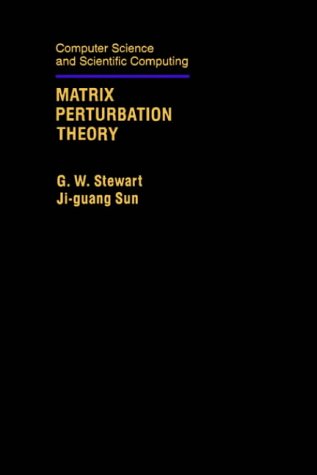Matrix perturbation theory by G. W. Stewart, Ji-guang Sun


Matrix perturbation theory G. W. Stewart, Ji-guang Sun ebook
ISBN: 0126702306, 9780126702309
Page: 376
Format: djvu
Publisher: Academic Press
I believe that there is a good approximation algorithm that will work for such stable matrices. Now we show Quantum Perturbation Theory in the case of perturbation independent from time. We argue that the entanglement entropy of and mutual information between subsets of field theoretic degrees of freedom at different momentum scales are natural observables in quantum field theory and demonstrate how to compute these in perturbation theory. Indeed, if one calculates the S-matrix by means of the “old” perturbation theory, one obtains exactly the same Lorentz-noninvariant result without introducing any new concept. Perturbation Theory: degenerate case. Coupled mode theory, scattering and transmission matrices, directional couplers, Mach-Zehnder interferometers, optical resonators. The minimum amount of information required to simulate a given stochastic process is a significant topic of study in the field of complexity theory, where it is known in scientific literature as statistical complexity. Researchers know how to calculate the The researchers calculated the information-storage requirements for a set of stochastic models describing a perturbed coin - a coin that flips at each time step with some probability p. The matrix elements of the perturbing Hamiltonian are calculated using the anharmonic interatomic force constants obtained from the interatomic potential as well. The interatomic interactions are modeled using the Tersoff interatomic potential and perturbation theory is applied to calculate the transition probabilities for three-phonon scattering. For them, the theorem is a means of constructing solvability conditions for linear equations used in perturbation theory. What it all boils down to is that we wish to be able to use non-degenerate perturbation theory: But in order to do this, the W-matrix has to be diagonal (that's what Griffiths concludes on page 271). This hunch is based on: intuition, the observation that JSV's counterexample is not stable, and finally on a nice connection to extrapolation. The relativistic many-body perturbation theory MBPT) calculations for matrix elements of divalent atoms and ions is extended to third-order. One nice example is non-relativistic QCD, which doesn't require large matrix inversions. Can the permanent of stable negative matrices be approximated? It is shown that the elements of this matrix can be calculated, by a consistent use of perturbation theory, to any desired order in the fine-structure constant. In fact we have infinitely many fake vacua in the perturbation theory, and in order to make realistic predictions, we need a complete formulation of string theory. Images Eric is part of the theory group at Georgia Tech, and can always be counted on to add a wry comment to any discussion the group has. We derive a relation between this density matrix and the Wilsonian effective action obtained by integrating out degrees of freedom with spatial momentum above some scale.